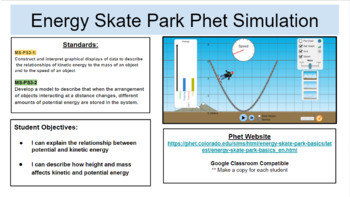Potential and Kinetic Energy Phet Skate Park Simulation Digital UDL Lesson
Kimberly Odenthal
66 Followers
Grade Levels
6th - 8th
Subjects
Resource Type
Standards
NGSSMS-PS3-2
NGSSMS-PS3-5
NGSSMS-PS3-1
Formats Included
- Google Slides™
- Webquests
Kimberly Odenthal
66 Followers

Made for Google Drive™
This resource can be used by students on Google Drive or Google Classroom. To access this resource, you’ll need to allow TPT to add it to your Google Drive. See our FAQ and Privacy Policy for more information.
What educators are saying
My students love interacting with PHET lab and this was a great resources to guide them through the activity.
This is exactly what I needed for my students. Outstanding product to help supplement within my instruction.
Description
Lesson on potential and kinetic energy using google slides and the phet energy skate park simulation. Interactive lesson with NGSS science standards made accessible for all students with UDL principals. Includes multiple slides of questions on the relationship of kinetic and potential energy and the affect of mass and height on kinetic and potential energy. Product also includes an extension activity.
Total Pages
Answer Key
N/A
Teaching Duration
N/A
Report this resource to TPT
Reported resources will be reviewed by our team. Report this resource to let us know if this resource violates TPT’s content guidelines.
Standards
to see state-specific standards (only available in the US).
NGSSMS-PS3-2
Develop a model to describe that when the arrangement of objects interacting at a distance changes, different amounts of potential energy are stored in the system. Emphasis is on relative amounts of potential energy, not on calculations of potential energy. Examples of objects within systems interacting at varying distances could include: the Earth and either a roller coaster cart at varying positions on a hill or objects at varying heights on shelves, changing the direction/orientation of a magnet, and a balloon with static electrical charge being brought closer to a classmate’s hair. Examples of models could include representations, diagrams, pictures, and written descriptions of systems. Assessment is limited to two objects and electric, magnetic, and gravitational interactions.
NGSSMS-PS3-5
Construct, use, and present arguments to support the claim that when the kinetic energy of an object changes, energy is transferred to or from the object. Examples of empirical evidence used in arguments could include an inventory or other representation of the energy before and after the transfer in the form of temperature changes or motion of object. Assessment does not include calculations of energy.
NGSSMS-PS3-1
Construct and interpret graphical displays of data to describe the relationships of kinetic energy to the mass of an object and to the speed of an object. Emphasis is on descriptive relationships between kinetic energy and mass separately from kinetic energy and speed. Examples could include riding a bicycle at different speeds, rolling different sizes of rocks downhill, and getting hit by a wiffle ball versus a tennis ball.





